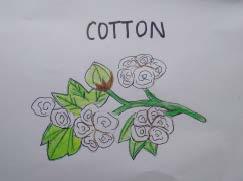Cotton

Cotton goods were brought by Alexander the Great's army in 300 BC. This was the earliest discovery of cotton. Ever since cotton has been domesticated by farming societies. Because of that, the use of cotton was introduced worldwide. Civilizations such as Chinese, Egyptian and South American began weaving cotton fabrics in 2500 BC. In 3000 BC, cotton was cultivated as a fabric in the Indus River Valley (now Pakistan). Today cotton is involved in the making of
various products.
Cotton is a soft, fluffy staple fibre that grows on cotton plants. It grows in a ball around the seeds of the plant. The fibre of cotton is almost pure cellulose.

No one knows exactly how old cotton is. Scientists searching Open Cotton Bollcaves in Mexico found bits of cotton bolls and pieces of cotton cloth that proved to be at least 7,000 years old. Cotton was used in the Old World from around 5000 BC. Evidence of cotton use has been found at Mehrgarh, on Kacchi Plain of Balochistan, Pakistan, where early cotton threads were preserved in copper beads.
Some of the oldest cotton balls were discovered in a cave in Tehuacán Valley, Mexico, and were dated to approximately 3600 BC. Evidence of cotton was found in Peru in the form of seeds and cordage dating to about 4500 BC as well.
In the 8th century, the Muslim conquest of Spain brought cotton to the rest of Europe. During the Middle Ages, cotton was a fabric in common use. It was hand-woven on a loom until the 1350s when the spinning wheel was introduced to Europe, which improved the speed of cotton spinning. When Christopher Columbus explored the Bahamas and Cuba, he found natives wearing cotton, which probably strengthened his belief that he had landed on the coast of India. Vasco da Gama, a Portuguese explorer, opened a sea road to Asia, which made caravans obsolete and allowed for heavier cargo.
The technology of cotton processing was moving west. Indian craftsmen protected the secret of how to create colourful patterns, but some of them were converted to Christianity and revealed their secret to French Catholic priest Father Coeurdoux who transferred it to France and planted the seed of the European textile industry.
Cotton's rise to global importance came through a few factors. Some types of cotton fabrics became popular in Europe, while the Middle class had become concerned with cleanliness and needed easily washable and colourful fabric. The East India Company introduced cotton to Britain in the 1690s. New inventions such as the spinning jenny, the water frame, and the spinning mule— and the industrial revolution in the 1770s made the British Midlands into a very profitable manufacturing centre. Due to the worker's poor working conditions: low wages, child labour, and 18-hour workdays with whom, British cotton products constituted 40.5% of European exports in 1784–1786.
The American cotton industry started growing with the invention of the cotton gin in 1793 by Eli Whitney. By the early 1830s, the United States produced the majority of the world's cotton, which lead to the expansion of slavery in the United States and by the 1850s, slaves made up 50% of the population of the states which produced the majority of cotton in the US: Georgia, Alabama, Mississippi, and Louisiana.
Today industrial production is mostly located in Asian countries like India, Bangladesh, China and Latin America.
Some facts about cotton:
Cotton is a completely natural fabric.
Cotton plants need to grow for over 200 days.
Cotton has been around for well over 8,000 years.
Cotton accounts for almost 40 percent of clothing manufacturing.
References
http://www.historyofclothing.com/textile-history/history-of-cotton/ https://www.agiboo.com/12-interesting-facts-about-cotton/
Author biography
Asiyath Shaj'aa Shafeeq is a 13 year old student currently studying in 6th grade in Jamaluddin School. She participated in the Circle Coding and Critical Thinking programme by the Ugail Foundation in the year 2021 and was selected as a member of the "Leaders of Tomorrow" programme led by Professor Hassan Ugail in the year 2022. She mostly read fantasy and adventure books. Her favourite author is J.K Rowling.

Cite this article as:
Asiyath Shaj'aa Shafeeq, Cotton, theCircle Composition, Volume 2, (2022). https://thecirclecomposition.org/cotton/
